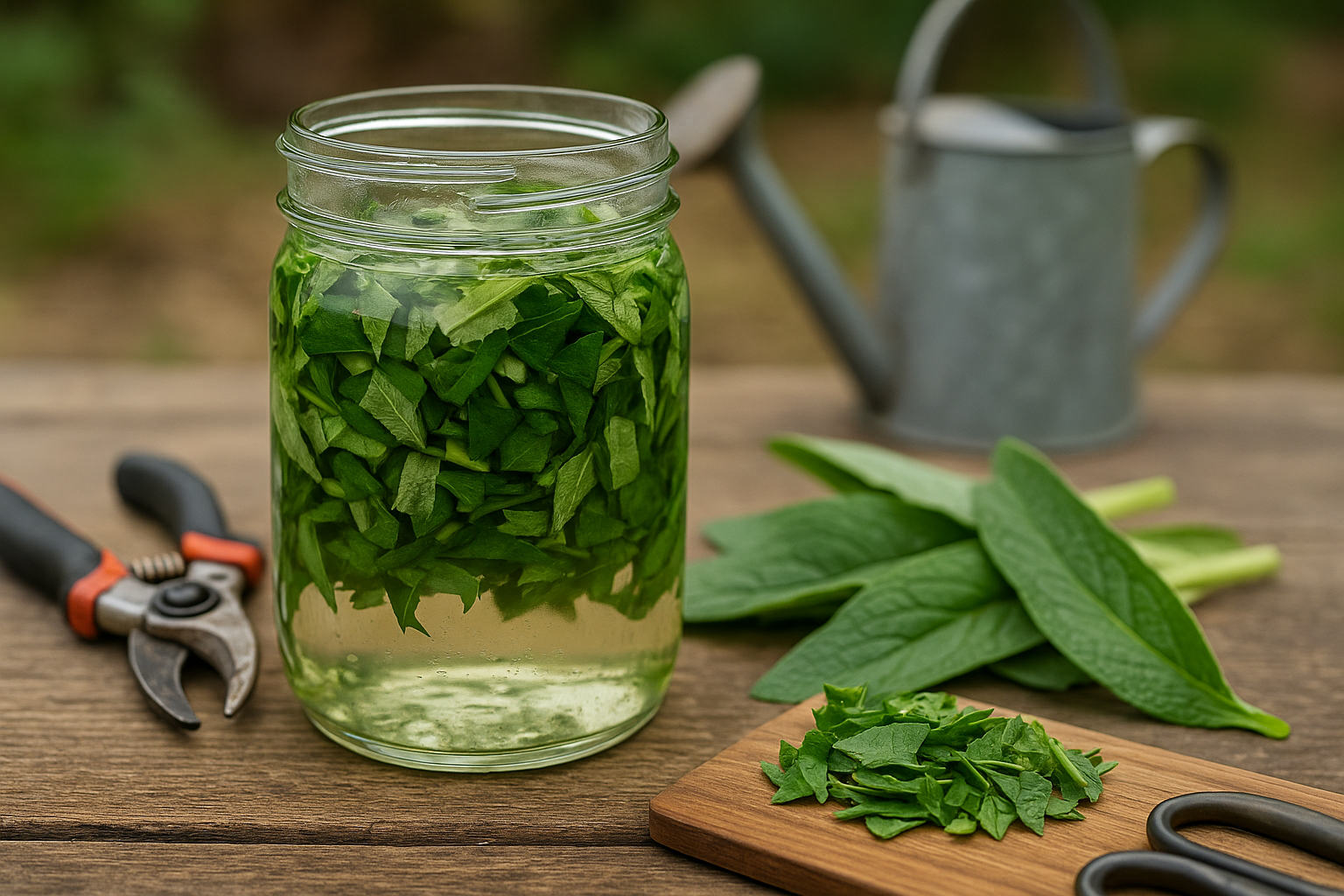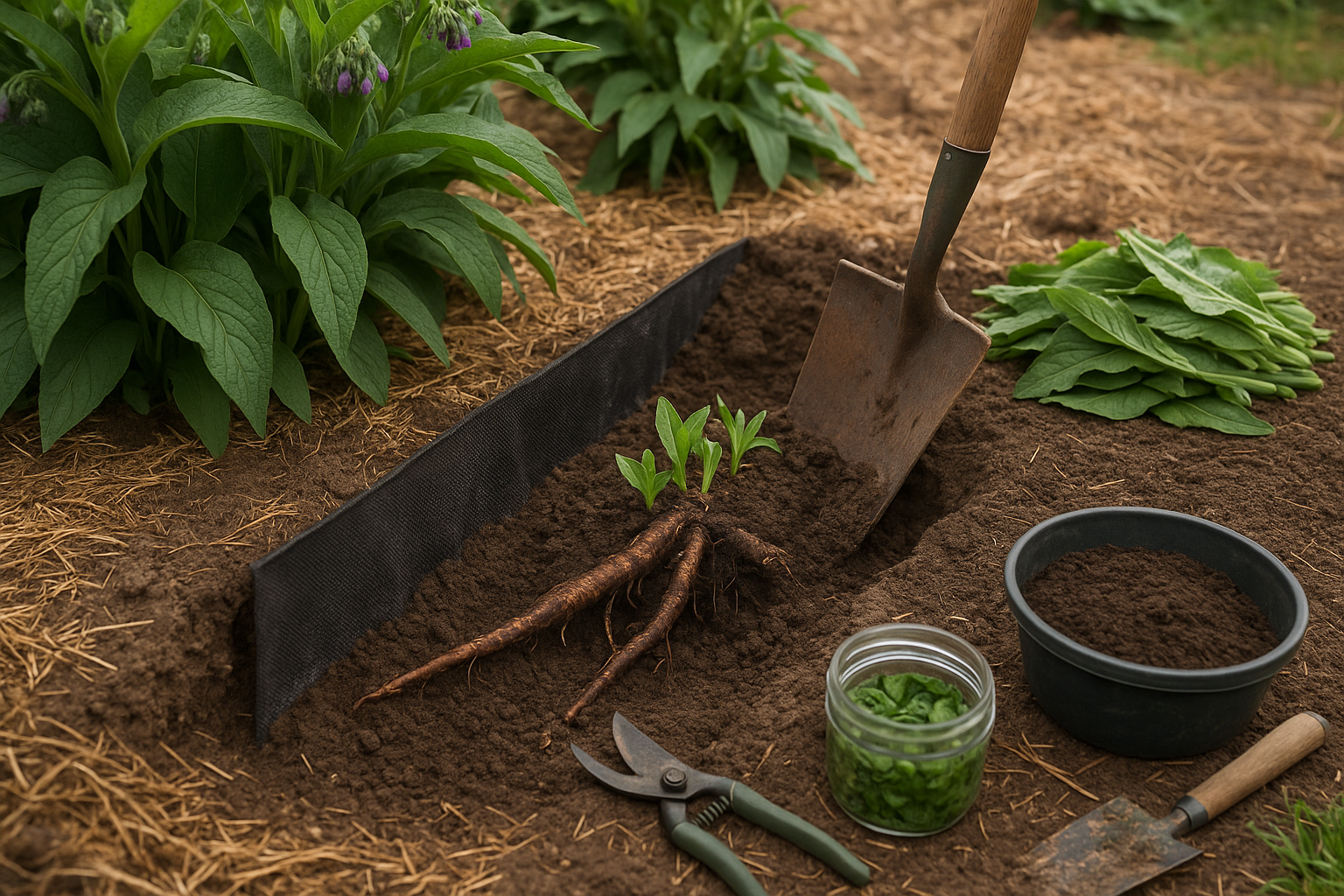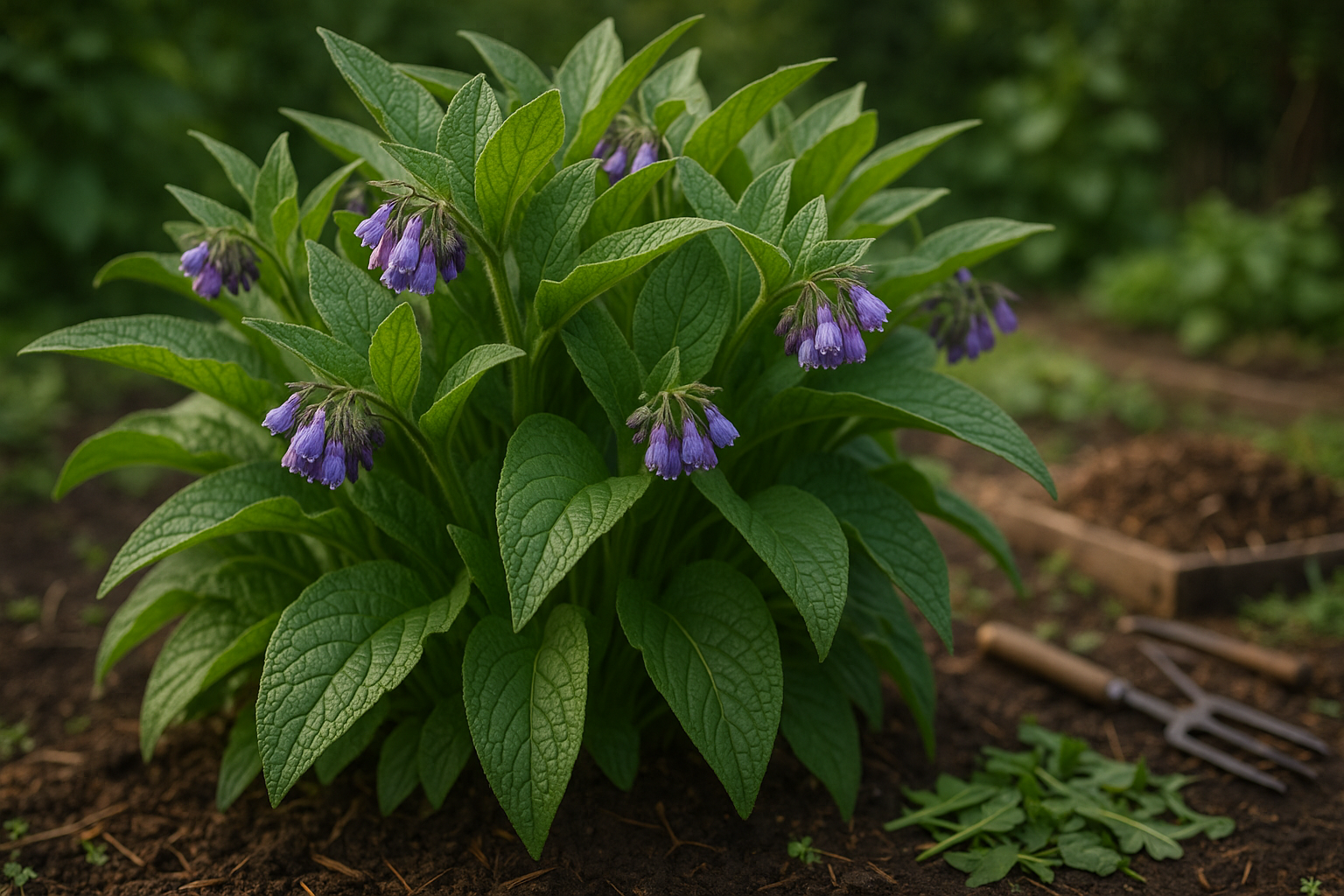What Is Comfrey?

Comfrey is a hardy perennial herb that has earned a permanent spot in many gardens thanks to its resilience and versatility. It is recognizable by its large, hairy, deep green leaves and clusters of bell-shaped purple, blue, or white flowers. Comfrey grows in dense clumps that can quickly reach up to three feet tall and wide. Its roots are long and deep, allowing the plant to thrive in a variety of soil conditions—even poor or compacted earth.
Gardeners often identify comfrey by gently rubbing its leaves, which have a rough, fuzzy texture. Because of its robust growth, once established, comfrey rarely needs much attention and can return year after year with little fuss.
The real reason so many gardeners choose to grow comfrey goes beyond its appearance—it’s a powerhouse for improving soil health and supporting other plants. The leaves are rich in nutrients, particularly potassium, making them an excellent ingredient for homemade liquid fertilizers or “comfrey tea.” Simply soak chopped leaves in water for a few weeks, then strain and use as a plant feed.
Comfrey’s fast-growing foliage also makes superb mulch or can be added to compost piles to speed up decomposition.
On top of its role in the garden, comfrey has a long history in herbal medicine, where its soothing leaves have traditionally been used in salves for minor skin irritations. However, modern use should be cautious due to potential health risks.
Whether you want to enrich your garden naturally or are drawn to its old-fashioned herbal uses, comfrey is an easy-to-grow, multi-purpose plant worth considering.
Is Comfrey Invasive? Understanding Its Growth
In gardening and ecology, the term “invasive” refers to a plant that spreads aggressively outside its intended area, often outcompeting native species and disrupting local ecosystems. Comfrey is sometimes labeled invasive, but it’s important to distinguish between true invasiveness and simply vigorous growth.
Comfrey spreads primarily through its deep and resilient root system, which can reach several feet underground. If you try to dig it up, any tiny root fragments left behind can regenerate into new plants, making it persistent in garden beds. Some comfrey varieties, especially the common species (Symphytum officinale), can also spread by seed if flowers are allowed to mature and drop.
However, the popular Bocking 14 cultivar is sterile and will not spread by seed, greatly reducing its potential to become invasive. In most home gardens, comfrey is best described as extremely robust rather than classically invasive.
Managing Comfrey Growth
Practically, if you keep comfrey in a defined area—such as raised beds, enclosed borders, or even large containers—you can control its expansion. Here are some tips to keep it in check:
- Harvest with care, digging roots as infrequently as possible to avoid accidental propagation.
- Mulch around the base to help smother stray shoots.
- Remove flower heads before seeds form to prevent spreading by seed.
For most gardeners, comfrey’s reputation comes more from its enthusiasm to grow than from any real threat to native plants or wild spaces. This is especially true when you choose the right variety and maintain simple boundaries.
So, while comfrey isn’t invasive in the same way as notorious plants like Japanese knotweed or kudzu, it does require some forethought and basic containment techniques to prevent it from overtaking areas where it’s not wanted.
Risks and Concerns
While comfrey is prized by many gardeners for its soil-improving properties, it can quickly become a headache in certain conditions. Comfrey is a vigorous grower with deep roots and can easily overtake garden beds, especially if not kept in check. Once established, even a small fragment of its root left behind after digging can regrow, making it tough to remove and potentially leading to it crowding out more delicate or slower-growing plants.
This is especially an issue in mild, temperate climates with regular rainfall, such as parts of the Pacific Northwest in the United States and areas of the United Kingdom, where comfrey can spread rapidly. In some regions, such as Australia and New Zealand, comfrey has earned an official warning as an invasive species, and gardeners are advised to plant it with caution or avoid it altogether.
To avoid problems, it’s best to plant comfrey in a contained area or use root barriers. Regularly monitoring your patch and promptly removing unwanted shoots can also help keep it under control. Ultimately, understanding comfrey’s aggressive growth habits and respecting local guidelines will keep your garden—and local ecosystems—healthy and balanced.
How to Control and Manage Comfrey Safely

Comfrey is a vigorous, deep-rooted plant known for its rapid growth and spreading habit. With careful management, you can keep it in check and enjoy its many benefits.
One of the most effective ways to control comfrey is by installing root barriers before planting. Dig a trench around the planting site and line it with heavy-duty landscape fabric or plastic, making sure it extends at least 18 inches deep to stop creeping roots from spreading beyond their designated area.
Regular trimming also helps; cut back comfrey leaves several times throughout the growing season to weaken the plant and prevent excessive self-seeding. Removing flower stalks as soon as they appear is crucial since comfrey can propagate from discarded seeds and flowers, quickly undoing your hard work.
If you need to remove unwanted comfrey, be prepared for a challenge—its thick, brittle taproots often regrow from even small pieces left in the soil. For best results, dig out as much of the root as possible, using a spade to loosen the earth deeply, and repeat this process several times over a season to catch any regrowth.
Planting comfrey in isolated spots, such as containers, raised beds, or areas bordered by concrete or paving, can further prevent invasion into lawns or garden beds.
Many gardeners find success by placing comfrey where its spread won’t be a problem—such as next to compost bins or along the edges of orchards, where its deep roots can draw up nutrients for use as mulch.
With consistent attention and a bit of planning, you can harness comfrey’s benefits for your garden without letting it take over.
Best Uses for Comfrey in the Garden and Beyond
Comfrey is a powerhouse plant for gardeners and herbalists alike, offering a range of practical uses both in the garden and around the home. One of the most popular ways to use comfrey is as a nutrient-rich mulch—just chop the large, hairy leaves and lay them around the base of tomatoes, potatoes, or fruit bushes. The decaying leaves act as a slow-release fertilizer, delivering vital nutrients like potassium and nitrogen right where plants need them most.
Comfrey is also a star ingredient in “compost tea,” a quick liquid feed made by steeping its leaves in water for a few weeks. It can also serve as a compost activator, helping to break down tougher organic materials faster in your heap.
Herbalists value comfrey for its traditional use in soothing minor wounds, sprains, or bruises—just remember, comfrey is best used externally, as some compounds can be toxic if ingested.
To prevent comfrey from taking over your garden, opt for sterile hybrid varieties like Russian comfrey (Symphytum x uplandicum), which don’t self-seed aggressively, and always trim flower heads before they set seed. Consider planting comfrey in raised beds or containers if space is limited, and dig up stray shoots promptly to keep it contained.
For those wary of comfrey’s enthusiasm, alternatives like borage, nettles, or even alfalfa can offer similar benefits for compost activation and mulching without the risk of spreading. With a little know-how, comfrey can be a sustainable, multi-purpose addition to any green space.
Summary
Comfrey is a powerhouse plant that offers a lot to the home gardener. Its deep roots pull up valuable nutrients, making comfrey leaves a fantastic addition to compost piles or as a natural mulch. Many people love it for attracting pollinators and as a source of organic fertilizer, especially for hungry crops like tomatoes.
However, comfrey’s vigorous growth can quickly become a challenge. If not managed carefully, some varieties—especially common comfrey (Symphytum officinale)—spread aggressively by seed or root fragments, sometimes taking over more space than intended.
For more responsible gardening, consider planting sterile varieties like Russian comfrey (Bocking 14), which won’t self-seed. Always use root barriers or plant comfrey in containers if you want strict control over its spread.
Before adding comfrey to your garden, honestly assess your needs and your ability to keep up with maintenance. If you have limited space or want a tidy, low-maintenance garden, comfrey might not be the best fit. On the other hand, if you’re looking for a tough, multipurpose plant and are prepared to manage its enthusiasm, comfrey can be a great asset.
Take time to weigh the benefits against the risks of invasiveness, and choose the approach that aligns with your gardening goals.
